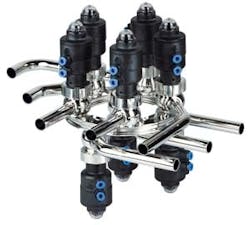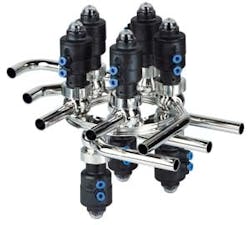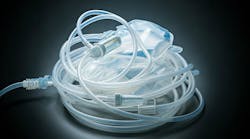Like so many pieces of plant equipment, valves show their true value when you don’t notice them at all. If you do notice them, it’s probably a sign of danger, downtime, or other assorted difficulties.
These three “d’s” spell trouble for the plant, and bad business forf the manufacturer. Genentech has two ways of monitoring the health of its valves, says Barkley Flynn, supervisor of sterilization, cool ops, and metrology at the South San Francisco facility. One is quarterly inspection of each valve. “This is highly labor-intensive,” Flynn admits. More recently, as part of its performance-based monitoring strategy, Genentech has implemented a wireless system by which it can constantly monitor valve functions. For steam valves, for instance, it gauges temperature drops; for cool ops, it looks at amp draw on compressors. If measurements exceed established control limits, an alarm is triggered and a master mechanic assesses the situation to see if the valve is sticking or truly wearing out.
Flynn says it’s all part of a strategy to get out of the “fire-fighting” business. “The idea is not brilliant,” he says. “It’s just taking the steps needed to push predictive maintenance.” Flynn estimates the payback for such monitoring is three to seven months. In many cases, operators would sooner replace a perfectly good valve than take the risk of it malfunctioning, and so monitoring the health of valves allows the company to extend the life of these pieces of critical equipment.
What does Flynn like in terms of today’s valves themselves? There’s a dizzying array of technologies on the market, he admits, from control to on-off valves, from those for delicate sanitary processes to robust industrial needs. One of the most critical factors he uses to select products is ease of installation—“Do I have to shut down my manufacturing system for a week, or can I do it without interrupting the process?” he asks. Cost and validation issues also factor in.
A good pharma valve has changed a lot over the years, says Charles O’Donnell, marketing manager for Emerson’s Baumann control valve product line. Polished internal components, sanitary seals, and good drainability are still essentials. One trend O’Donnell has seen of late is a movement towards smaller, lighter products, to conform to the needs of moveable process skids and flexible manufacturing. “It’s something we keep in mind whenever we develop a new product,” he says. Another trend is designing valves with simplicity in mind—fewer curves and angles, for example—so that each valve will conform to various end connections and lend itself better to overall versatility, O’Donnell adds.
And, as Flynn noted, monitoring is critical. O’Donnell says that Baumann valves come equipped with Fieldvue digital valve controllers (DVC’s) that pass information about critical parameters on to the manufacturing control system. “Especially in a validated environment, you really need to know what’s going on with your valves,” he says. “You need a system that can give you an indication that there could be a problem, and point you to where the problem may lie.”
With so much competition out there, valve manufacturers are bending over backwards to distinguish themselves. What follows is a survey of some of the latest technologies available, in valves large and small, for plant and process operations:
GEA Tuchenhagen’s VESTA line includes sterile valves for tank bottoms, multiport operations (photo), control, and standard two-way valving—useful pretty much anywhere in pharma clean rooms, says Dave Medlar, company president. One valve range can be used for clean steam control, WFI, CIP, fermentation, etc.GEA developed the bellow technology for applications in other industries and translated it to pharma. It’s still somewhat new to pharma and requires a “leap of faith” for pharmaceutical professionals to buy in, Medlar says. “People in the industry are so used to diaphragms—it’s ingrained in their minds,” Medlar says. “When something else comes along, it takes a few years to catch on.”
Aquasyn makes and markets high-purity diaphragm valves specifically for the drug industry. “Most companies took their existing technologies and made them stainless steel for the pharmaceutical and biotech industries,” says operations manager Dean Richards. “We went out and talked to customers about what their requirements were, and then made our products specifically for them.” One departure from the norm is what the company calls Tork-Tite feet that establish metal-to-metal contact from bonnet to the valve body, eliminating the chance for overtightening and damage to the diaphragm, Richards says. Aquasyn valves range from ¼-inch to 6-inch, for applications ranging from fermentation and chromatography to CIP and WFI.
ASCO Numatics, a division of Emerson Industrial Automation, recently introduced the Numatics Foundation Fieldbus H1 Valve Manifold, an automated product for on/off valve needs in the life sciences. It’s the only valve manifold on the market with Fieldbus H1 protocol capability, says Bill Reeson, the company’s senior marketing manager for the process control industry. A manufacturer will usually have so many on/off valves that it’s too expensive to control them all via Fieldbus. The manifold eliminates this concern for many manufacturers. “The only limitation is how many I/O controls you have,” Reeson says. “Each manifold is one Foundation Fieldbus node, and it can automate up to 16 on/off valves.” Plants with sufficient control channels, or segments, can get away with using just one control network, he says.
Traditional pneumatic valves used as pilot valves still offer the best solution for most applications because of their availability, cost, and simplicity. Festo, however, is using piezo technology to enable valves to operate at lower energy levels, which makes them practical for Foundation Fieldbus or explosion-proof applications. Festo does not market the valves directly, says Craig Correia, Festo’s manager of Process Automation, but works with process valve and process valve control device manufacturers to embed the technology into their products—a specialized solution that makes it viable mainly for high-volume applications. Those applications for pharma would primarily be within positioners (or other process valve control devices) which require proportional control and low currents, Correia says.
Festo is further establishing its energy audit services which focus on efficiency and conservation of compressed air. Festo has released its GFDM package, which customers can integrate into their compressed air systems to have the ability to monitor air consumption and air quality. The GFDM will interface will current controls and push alerts if system conditions fall outside acceptable levels, Correia says.
Millipore’s NovAseptic valves have a radial (as opposed to weir) diaphragm that, the company says, enables a flow path free of entrapments or impingements, meaning complete recovery of products from holding tanks or separation systems. The design also allows for easier cleaning and a lower likelihood of deadlegs, says Millipore. For SEC chromatography, for example, this means a reduced void volume and better performance. Shown here is a modular valve for flow control on a chromatography skid.
Badger Meter’s SCV85 and SCV89 sanitary control valves are suited to the automated control systems found in biotech and pharma. Common uses are pressure, temperature and flow control in fermentation reactors; control of gas blankets in closed vessels; and catalyst, defoamer, and additive initiation. Badger offers a choice of 17 types of innervalves.
Burkert ELEMENT valves (as well as sensors and controllers) are a combination of hygienic polymers and stainless steel, and handle corrosive solvents and chemicals or abrasive fluids such as slurries. The valves have LEDs or backlit graphics, and communicate with enterprise systems through a range of protocols.
The DELTA AP1 from APV is an aseptic stainless steel diaphragm valve with a fan support system meant to add diaphragm life. The support system facilitates pressures up to 10 bar in open and closed positions. A flat diaphragm design helps to reduce wetted surface and cleaning time.
The Swagelok DR series radial diaphragm valves feature a single body valve design to minimize entrapment areas, and are meant to handle applications ranging from media prep and fermentation, to purification and CIP/SIP. “The valve construction is designed to perform under higher steam cycles, thermal cycles and working pressures than standard weir-style valves,” says market manager Mike Bridge. “With precise open and close control, they are well suited for point of use control of critical process, such as fill and blend.” The valves are 316L stainless steel with PTFE wetted single-piece diaphragms. Sizes from ½-inch to 2-inch are available.
Baumann’s 84000 series sanitary control valve has been around for some time, but the company has recently tweaked it for tighter control and for use in temperatures up to 320°F, says O’Donnell. It’s the only diaphragm control valve on the market, he says. Standard sanitary control valves use a plug to control flow, resulting in high fluid velocities and shearing forces, he says, whereas the shape of the 84000 results in low shear, making it safe for sensitive bio-media. Applications include backpressure control for cross and tangential flow filtration and clarification, buffer addition for chromatography, and mammalian cell transfer and nutrient feed.
Magnatrol specializes in industrial-grade valves—“no parts, no plastics . . . they can take a shot,” says tech support specialist Dave Califiore—and for pharma offers stainless steel solenoid valves for myriad applications: HVAC, water pretreatment and distribution, steam control, and even reverse osmosis systems. Magnatrol is one of the few solenoids with zero differential pressure requirements, a useful thing for low-pressure operations common in pharma. The new three-inch valve is shown here.
Plast-O-Matic Valves has developed a thermoplastic, air-operated pinch valve with a newly designed sleeve element that, says marketing manager Rick Bolger, lasts up to five times longer than traditional designs. It is molded from EPDMh2, an Ethelyne-Propylene-Diene-Monomer that helps the pinch element to achieve over 1,000,000 cycles under test conditions.
Pinch valves use a normally-open sleeve element to control flow. They offer an open flow path and are especially suited to slurries and other media with particulate, Bolger says, since the elastomer sleeve will seal around solids that might prevent more common valve types from closing.







